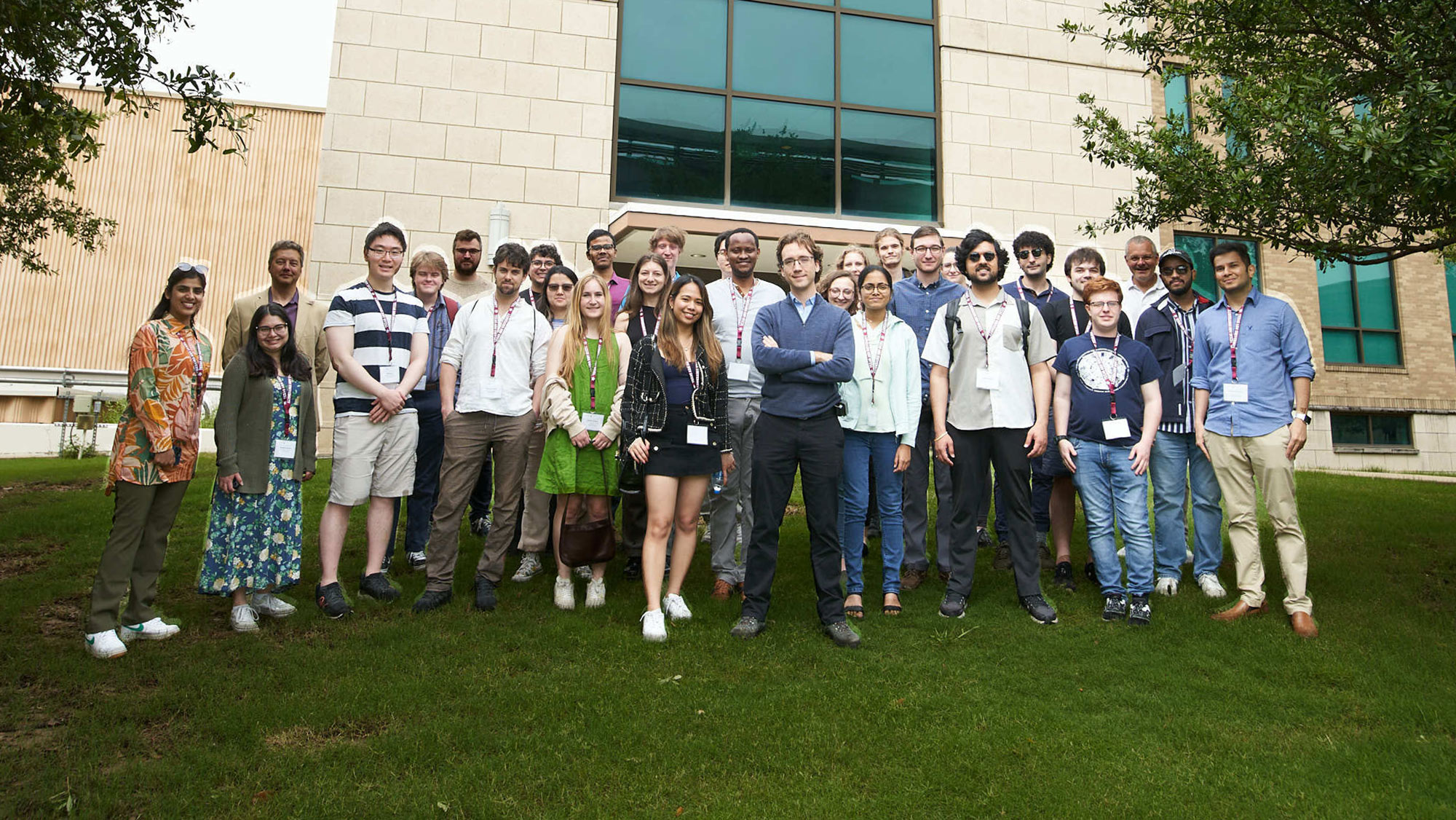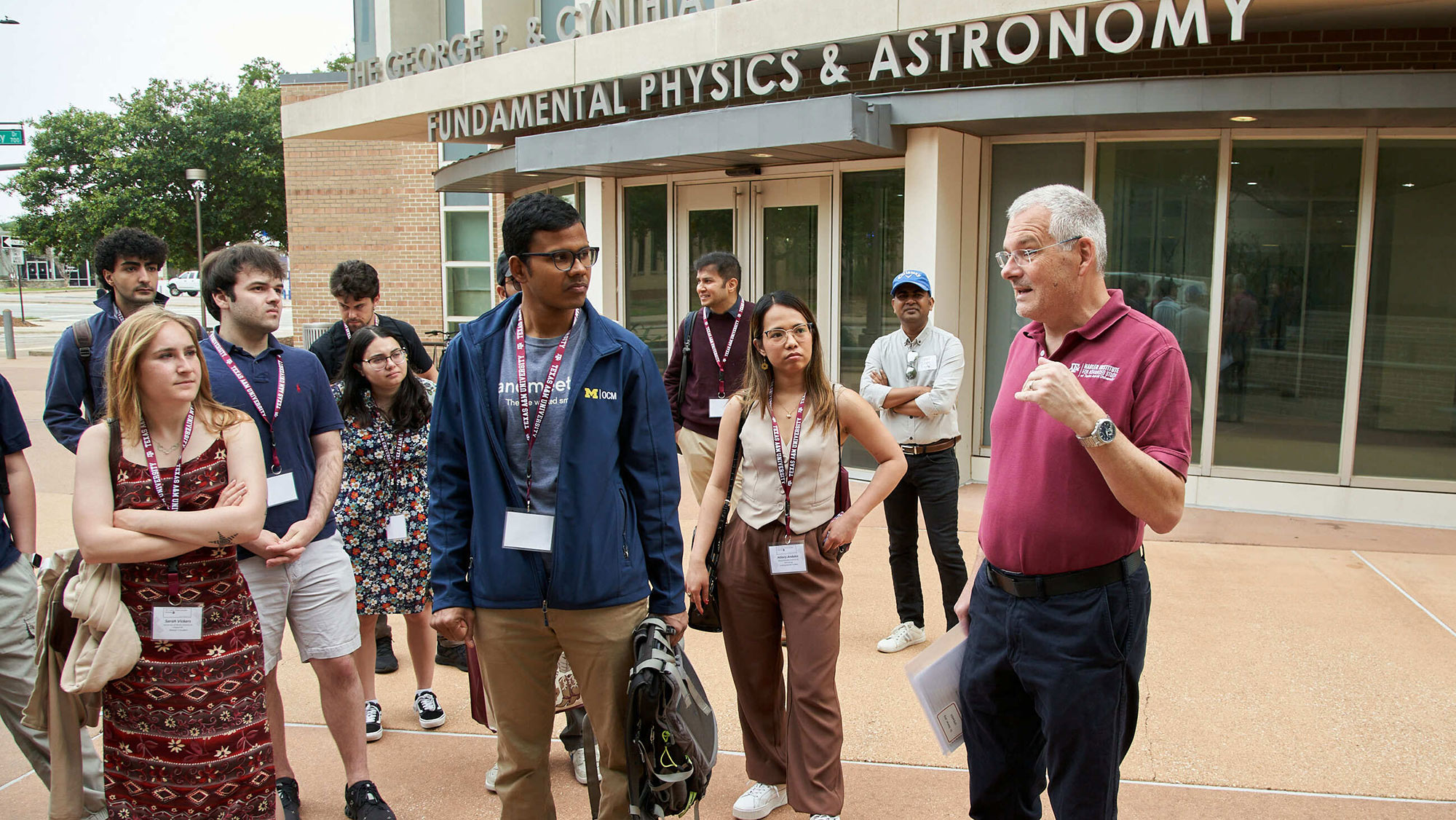
A select group of young scientists gathered at Texas A&M University last week in preparation for the upcoming 73rd Nobel Laureate Meetings in Lindau, Germany.
The young scientists — a total of 32 students and post-doctoral researchers from across the country — will join more than 600 of their peers from around the world at meetings set for June 30-July 5.
Seven students and one post-doctoral researcher from Texas A&M, including three from Texas A&M Engineering, will be among the participants. The scientists were nominated to participate in the gathering by their institutions and then selected by Lindau’s scientific review panel.
The gathering on the Texas A&M campus allowed the participants to tour the campus and research facilities, network with the group members and meet with Texas A&M faculty and administrators. With support from the Department of Physics and Astronomy and the College of Arts and Sciences, the group visited the Cyclotron Institute, the Institute for Quantum Science and Engineering, and the Mitchell Institute for Fundamental Physics, among other sites.
Kamal Rudra, who recently completed a master’s degree at the University of Michigan, said the workshop on campus was a great opportunity to meet peers and faculty and learn about what motivated their interest in their research.
“What I keep noticing in their stories is that innovative scientists often encounter initial rejection of their ideas,” Rudra said. “I am always inspired by how people persevere through those kinds of challenges. At Lindau, we’re going to get to meet people who overcame those challenges and conducted research that changed the world. What’s more inspiring than that?”
At Lindau, we’re going to get to meet people who overcame those challenges and conducted research that changed the world. What’s more inspiring than that?
The campus visit was coordinated by the Office of the Provost, in collaboration with the Division of Research, the Graduate and Professional School, the Office for Faculty Affairs and the Hagler Institute for Advanced Study.
The two-day event represents one aspect of a larger initiative at Texas A&M.
The university has reached a four-year agreement with the Lindau Nobel Laureate Meetings Foundation to be one of the organization’s main U.S. academic partners outside California; the University of California System has a similar agreement with Lindau to provide opportunities for young scientists from California. As part of that agreement, Texas A&M will conduct a first round of nomination reviews before forwarding selected nominees to the Lindau scientific review panel to make final decisions and extend invites to the annual meeting. The university will then host a pre-Lindau Meeting preparatory session on campus and support the travel for a number of those invited.
This summer, Texas A&M will support 21 of the 32 students and post-docs selected to attend the Lindau Nobel Laureate Meetings. The other 11 will be supported by corporate partner Amgen. In addition, Texas A&M will host “International Day” at Lindau, which opens with a partner breakfast and panel discussion on the role of physics in solving the global problems of the 21st century featuring Nobel Laureate Bill Phillips and two faculty and one young scientist from Texas A&M. The day will conclude with cross-cultural sharing of food and activities.
Dr. Joerg Steiner, university distinguished professor of veterinary medicine and faculty liaison for the Office of the Vice President for Research, has spearheaded the initiative. “Texas A&M is filling an important need in the U.S.,” Steiner said. “Outside of California, there’s no U.S. academic institution doing what we’re doing.”
Dr. Alan Sams, executive vice president and provost at Texas A&M, said it was an honor to host the scholars to help them prepare for the meeting in Germany.

“Attending a Nobel Laureate Meeting is transformational for a young scientist. We’re giving the most promising students and post-docs at Texas A&M and around the country a chance at a potentially life- and career-changing experience and we’re preparing them to make the most of that experience,” Sams said. “In addition, we get an opportunity to showcase our university by bringing young scholars from around the country to our campus and showing them all our university has to offer, then sending them to Lindau as a cohort supported by Texas A&M.”
The Lindau Nobel Laureate Meetings provide an international forum for intellectual exchange and collaboration. The event, which was established in 1951, features lectures, discussions and workshops that cover a range of scientific disciplines, rotating annually between physics, chemistry, and physiology or medicine, with a meeting dedicated to economics every three years. This year, nearly 40 Nobel Laureates in physics will be in attendance.
Hannah Dattilo, a doctoral student at Vanderbilt University, said she is most interested in the exchange of ideas with such accomplished researchers. “Events like this and Lindau,” Dattilo said, “are hallmarks of what collaboration looks like, and they contradict the stereotype of the mad scientist working alone in a lab. Working together and sharing ideas and insights is how we move science forward.”
Texas A&M students said they enjoyed having the workshop on campus and are proud that Texas A&M has partnered with Lindau.
“These two days have been like a crash course in cutting-edge research,” said David Thomas, a senior mechanical engineering major. “I am just trying to soak it all in, and having a small community will make it easier to interact with the larger community at Lindau. This has been a great primer.”
These two days have been like a crash course in cutting-edge research. I am just trying to soak it all in, and having a small community will make it easier to interact with the larger community at Lindau. This has been a great primer.
Alex Strasser, a Texas A&M doctoral student in materials science and engineering, said he was excited about the university’s effort through the initiative to connect students and the university with the international scientific community.
“I am interested in philosophical questions surrounding physics,” Strasser said. “I have already been blown away by the diversity of ideas on this topic just from the students and post-docs I’ve met here. I’m excited to see the perspectives from people of different cultures I’ll encounter at the meeting in Lindau.”
Sams said he was pleased that the students and post-docs were getting so much out of the workshop and were excited for their upcoming trip.
“We hope we are building lifelong relationships between our university and these future scholars. Perhaps the next time they visit Lindau, they will be faculty researchers representing Texas A&M as Nobel Laureates.”
Engineering Students Selected to Attend the 73rd Lindau Nobel Laureate Meeting, Supported by Texas A&M:
- Alex Hilty, computer engineering undergraduate student, Texas A&M University
- Alex Strasser, materials science and engineering doctoral student, Texas A&M University
- David Thomas, mechanical engineering undergraduate student, Texas A&M University
Students and Post-Docs Selected to Attend the 73rd Lindau Nobel Laureate Meeting, Supported by Texas A&M:
- Kevin Allen, doctoral student, Rice University
- Hillary Diane Andales, undergraduate student, Massachusetts Institute of Technology
- Keyu Ding, doctoral student, University of South Dakota
- Madison Edwards, doctoral student, Texas A&M University
- Addy Evans, doctoral student, Texas A&M University
- Pratiksha Balasaheb Gaikwad, doctoral student, University of Florida
- Shachar Gottlieb, undergraduate student, Texas A&M University
- Gabriel Larios, post-doc, Texas A&M University
- Adrià Delhom i Latorre, doctoral student, Louisiana State University
- Siyang Li, doctoral student, Johns Hopkins University
- Ali Binai Motlagh, doctoral student, Columbia University
- Emery Nibigira, post-doc, University of Tennessee
- Junellie Gonzalez Quiles, doctoral student, Johns Hopkins University
- Sarah Vickers, master’s student, University of North Carolina
- Jiaxuan Wang, doctoral student, Texas A&M University
- Ziqin Yue, doctoral student, Rice University
- Barkotel Zemenu, undergraduate student, Yale University
- Michael Zengel, undergraduate student, University of Alabama
Students and Post-Docs Attending the 73rd Lindau Nobel Laureate Meeting and the Pre-Meeting Workshop, Supported by Amgen
- Jeffrey Backus, doctoral student, Princeton University
- Hannah Dattilo, doctoral student, Vanderbilt University
- Dipa Ghindani, post-doc, Harvard University
- Miriam Hiebert, post-doc, University of Maryland
- Noah Hoppis, doctoral student, University of Maryland
- Pratik Prasad Joshi, post-doc, University of Illinois at Urbana-Champaign
- Anurag Panda, post-doc, Harvard University
- Kamal Rudra, master’s student, University of Michigan
- Adam Shaw, doctoral student, California Institute of Technology
- Ariana Shearin, doctoral student, University of Maryland
- Kathryn Sturge, doctoral student, University of Maryland